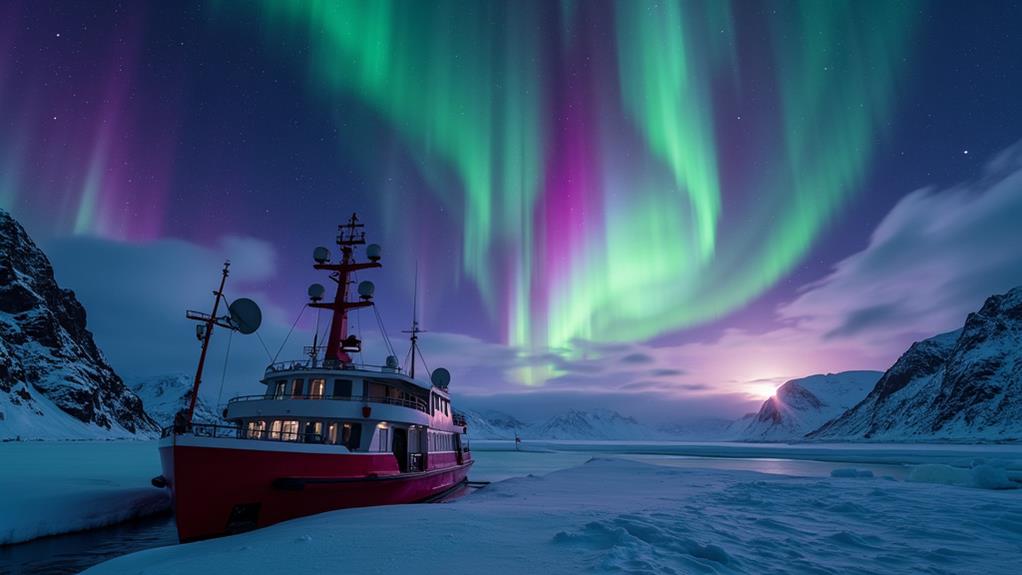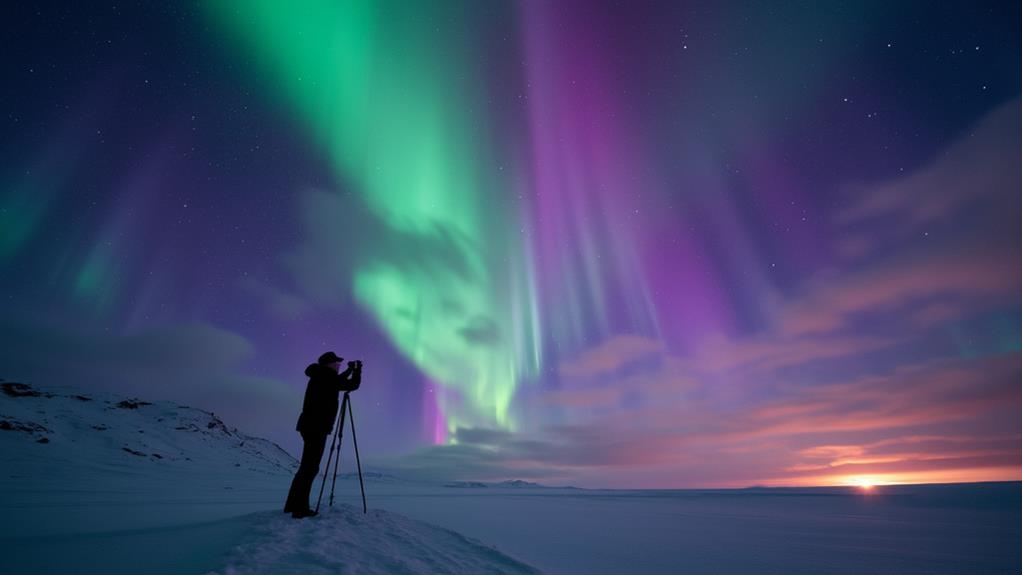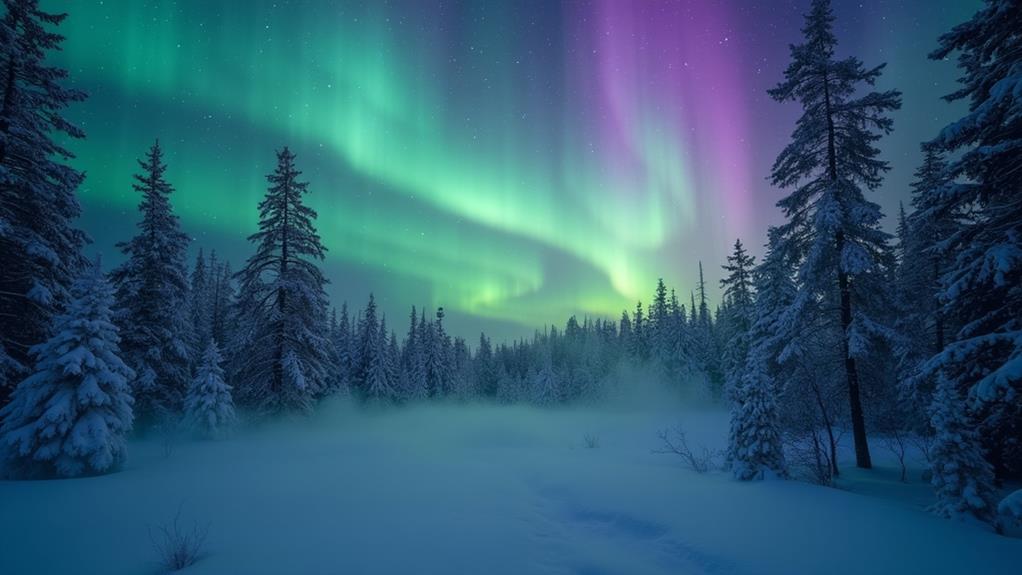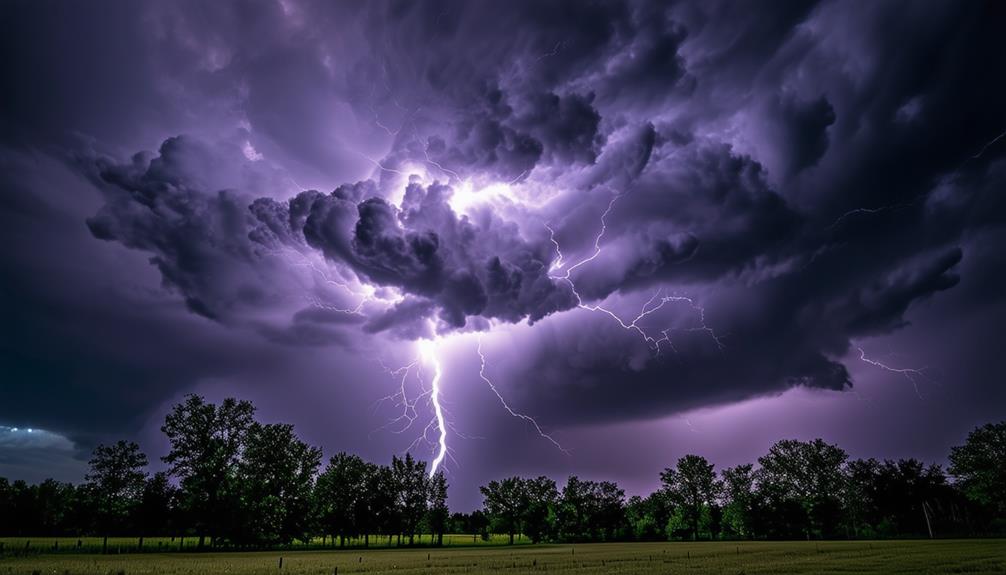The Difference Between the Northern and Southern Lights
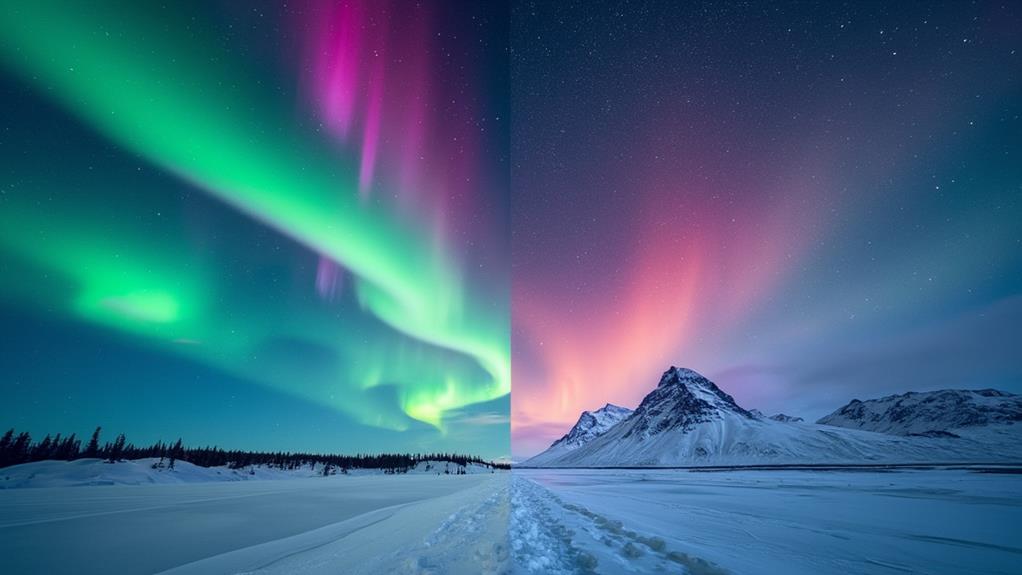
The Northern Lights (Aurora Borealis) and the Southern Lights (Aurora Australis) are both mesmerizing natural phenomena resulting from solar wind interactions with Earth's magnetosphere. While they share similar origins, notable differences exist in their visibility, color variations, and cultural significance. The Northern Lights are more famous, partly due to their accessibility and the number of populated areas within the auroral oval in the Northern Hemisphere. Atmospheric conditions, such as the type of gas particles involved, affect the colors observed, ranging from green to red to purple. Understanding these differences enhances your appreciation of both auroras and can guide your travel plans. Additionally, advancements in technology can significantly enhance your viewing experience, providing real-time forecasts and optimal viewing locations.
Geographic Locations
Witnessing the breathtaking Northern and Southern Lights requires choosing the right geographic locations. For the Northern Lights, or aurora borealis, high-latitude regions near the Arctic Circle provide the best viewing opportunities. Countries like Norway, Sweden, Finland, Canada, and the U.S. state of Alaska are prime destinations. Key locations such as Tromsø in Norway and Yellowknife in Canada are renowned for their frequent aurora activity and low light pollution, making them ideal for observing the shimmering lights.
On the other hand, the Southern Lights, or aurora australis, are primarily visible around the Antarctic Circle. These lights are equally stunning but often harder to access due to their remote locations. Tasmania in Australia, particularly Eaglehawk Neck and Mount Wellington, and Stewart Island in New Zealand are notable viewing areas. Occasionally, parts of South America, such as Chile and Argentina, also offer glimpses of this natural phenomenon.
While the Northern Lights have more accessible viewing spots thanks to the presence of land masses, the Southern Lights are typically seen in more isolated regions. This can make planning your trip more challenging, but the experience is well worth the effort.
Cultural Significance
The allure of the Northern and Southern Lights transcends mere visual spectacle, deeply embedding itself into the cultural fabric of diverse societies. The aurora borealis holds profound cultural importance in Indigenous Arctic cultures. For many, these lights symbolize the spirits or ancestors guiding the living. In Scandinavian folklore, the Northern Lights were believed to be the reflections of the Valkyries, the warrior maidens who determined the fates of soldiers in battle.
Similarly, the aurora australis captivates the Indigenous Maori culture in New Zealand, where the Southern Lights are associated with ancestral spirits and the creation of the world. These natural phenomena are not merely stunning displays; they have inspired numerous local legends, artistic expressions, and festivals. These cultural celebrations honor the awe-inspiring auroras, attributing different meanings based on regional beliefs and traditions.
The visibility of the auroras has led to a rich tapestry of cultural interpretations. Despite the variations in stories, the cultural significance of both aurora borealis and aurora australis underscores a universal human inclination to find deeper meaning in the natural world. These lights continue to inspire and shape cultural narratives globally.
Scientific Explanation
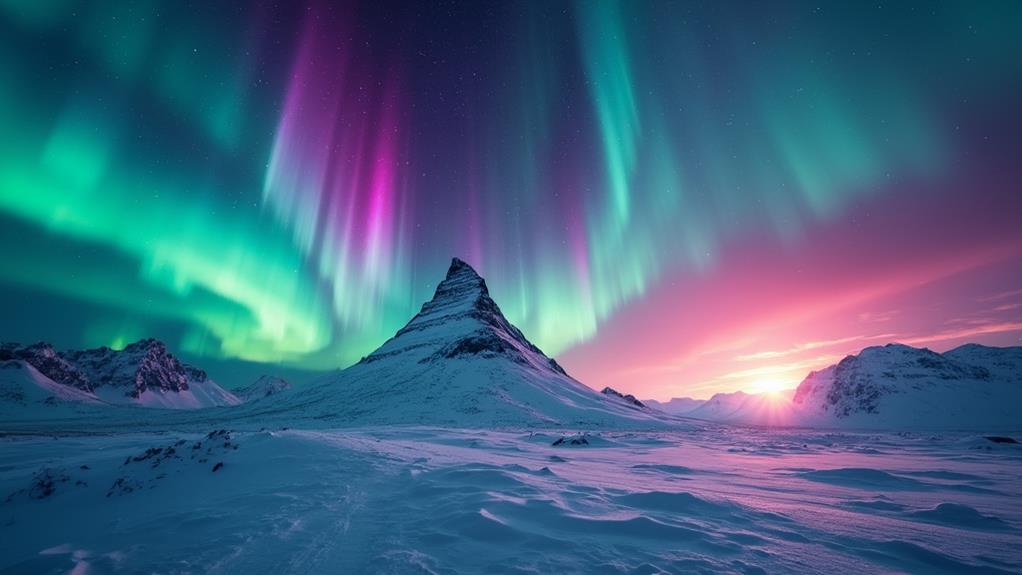
To grasp the science behind the Northern and Southern Lights, one must understand the interaction between solar wind and Earth's atmosphere. Charged particles from the sun collide with atmospheric atoms, releasing photons and creating stunning light displays. The Earth's magnetic field channels these particles toward the poles, resulting in the auroras' distinct patterns and colors.
Solar Wind Interaction
When high-energy particles from solar winds collide with atoms in Earth's atmosphere, they create the mesmerizing phenomenon known as auroras. These charged particles, mainly electrons and protons from the sun, are directed toward Earth by its magnetic field. Upon reaching the magnetosphere, these particles are funneled toward the polar regions, where they interact with atmospheric gases.
In the case of the Aurora Borealis, or Northern Lights, this interaction typically occurs in the northern hemisphere. The solar winds, containing the charged particles, cause collisions with oxygen and nitrogen atoms in Earth's atmosphere. These collisions excite the atoms, causing them to emit photons, which are particles of light. The resulting light emissions are what you see as the vibrant colors of the auroras.
The color variations depend on the type of gas and the altitude at which these collisions occur. For instance, oxygen can produce green and red hues, while nitrogen often results in blue and purple shades. The intensity and patterns of these auroras are influenced by solar activity; stronger solar winds can lead to more intense and widespread displays, making them even more spectacular to witness.
Atmospheric Particle Collisions
Auroras, often perceived as magical, are actually the result of intriguing scientific phenomena. The northern lights, or aurora borealis, occur due to atmospheric collisions triggered by solar winds. When these high-energy particles from the sun collide with Earth's atmosphere, they excite atoms and molecules, leading to the emission of light.
Here's how the process unfolds:
- Solar Winds: Charged particles flow outward from the sun, traveling through space.
- Magnetic Field: Earth's magnetic field directs these particles towards the polar regions.
- Atmospheric Collisions: High-energy particles collide with atmospheric gases.
- Color Displays: Different gases emit distinct colors; oxygen produces green and red, while nitrogen contributes blue and purple.
These displays are more common near the poles, where the magnetic field lines guide the particles and the atmospheric density is lower. The variations in color arise from the type of gas involved in the collisions. Oxygen generates green and red hues, while nitrogen results in blue and purple shades.
The intensity and frequency of the northern lights are closely linked to solar activity. Stronger solar winds lead to more vivid and frequent displays. The next time you witness an aurora, you'll understand the remarkable science behind it.
Magnetic Field Influence
Understanding the role of the Earth's magnetic field is essential for grasping how auroras form and evolve. The Earth's magnetic field, similar to a bar magnet, directs charged particles from solar winds towards the polar regions. These particles collide with atmospheric gases, creating the stunning displays known as auroras.
Solar winds can significantly alter the alignment of the Earth's magnetic field lines. When these winds are strong, they can distort the magnetic field, resulting in different auroral patterns in the northern and southern hemispheres. During periods of intense solar activity, the Northern and Southern Lights may not mirror each other perfectly. This asymmetry reflects how the magnetic field responds to varying solar wind pressures.
At the polar regions, the convergence of magnetic field lines intensifies auroral activity. Here, the interaction between solar particles and the magnetosphere is most pronounced, leading to brighter and more dynamic auroras. These magnetic field lines can shift positions in response to solar winds, causing localized auroras to move. This dynamic relationship underscores the responsiveness of the Earth's magnetosphere to changes in solar activity, making each auroral display unique.
Color Variations
Ever wondered why the auroras display such brilliant colors? The color variations in the Northern Lights (Aurora Borealis) and Southern Lights (Aurora Australis) are primarily due to interactions between solar particles and the Earth's atmosphere. Here's a breakdown:
- Green: The most prevalent color, produced when solar particles collide with oxygen at lower altitudes.
- Red: Less common, this color emerges from collisions with oxygen at higher altitudes.
- Blue and Purple: These hues are emitted by nitrogen molecules excited by solar particles.
- Gold and Orange: These colors are more noticeable in the Southern Lights, partly due to less light pollution in Antarctic regions.
These interactions depend on atmospheric conditions, such as the composition and density of gases at various altitudes. While both the Northern and Southern Lights can exhibit similar color patterns, the Southern Lights often display a broader spectrum. The clearer skies over Antarctica enhance the visibility of colors like gold and orange.
The next time you witness an aurora, remember that each hue represents solar particles interacting with our planet's atmosphere, creating the stunning color variations you see.
Best Viewing Times
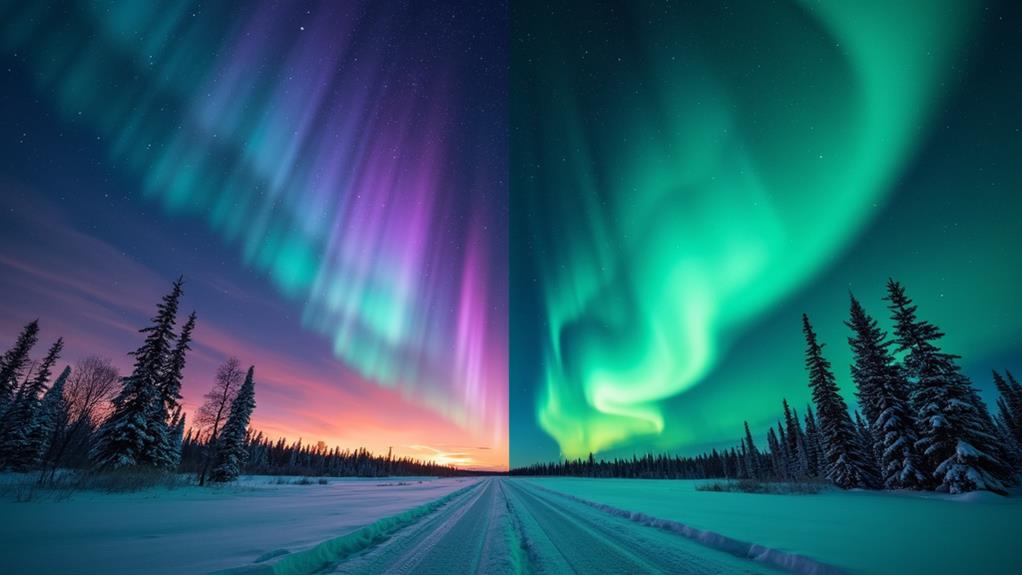
Timing is crucial for witnessing the awe-inspiring Northern and Southern Lights. The optimal period to view the Northern Lights, or Aurora Borealis, is from late September to mid-March, with peak visibility from late August to early April in locations like Iceland. For the Southern Lights, or Aurora Australis, the best time is from mid-March to early September, with May often being the peak month for sightings.
Planning your viewing around new moon phases is essential, as the darker skies enhance visibility. Clear, cloudless weather is also a significant factor; even if you're in the right location at the right time, cloud cover can obstruct your view.
Monitoring solar activity is key. The Kp index measures this activity, with higher values indicating a better chance of seeing auroras. Periods of heightened solar wind, reflected by a high Kp index, are particularly favorable. Keeping an eye on Kp values can significantly improve your chances of experiencing these natural wonders.
Viewing Locations
When planning to see the Northern Lights, you should consider places like Tromsø, Norway, and Yellowknife, Canada, which offer high visibility and minimal light pollution. For the Southern Lights, Eaglehawk Neck in Tasmania and Stewart Island in New Zealand provide stunning natural backdrops. Timing is essential, so knowing the best seasons and locations will increase your chances of witnessing these spectacular light shows.
Prime Viewing Spots
Aurora enthusiasts have a variety of prime viewing spots around the world to witness stunning displays of the Northern and Southern Lights. Here are some of the best locations:
- Tromsø, Norway: Known for minimal light pollution, Tromsø is a gateway to the Arctic Circle and offers unobstructed views of the Northern Lights.
- Yellowknife, Canada: Dubbed the "Aurora Capital of North America," Yellowknife offers over 300 nights of Northern Lights activity annually, thanks to its clear skies.
- Grótta, Iceland: This nature reserve near Reykjavik is favored for its low pollution levels and clear views, making it an excellent spot to see the Northern Lights.
- Eaglehawk Neck, Tasmania: For the Southern Lights, this coastal town offers rugged landscapes and clear vistas, enhancing the viewing experience of the aurora australis.
These locations provide exceptional opportunities to witness the breathtaking beauty of the Northern and Southern Lights.
Seasonal Best Times
Curious about the best times to witness the awe-inspiring Northern and Southern Lights? For the Northern Lights, target late September to mid-March. These winter months offer the longest, darkest nights, creating optimal conditions for viewing. Renowned locations like Tromsø, Norway, and Yellowknife, Canada, are ideal for experiencing this natural phenomenon. Their minimal light pollution and high auroral activity make them prime spots during this period.
For the Southern Lights, the peak season extends from mid-March to early September, with May offering particularly good visibility. To capture this stunning display, head to Eaglehawk Neck in Tasmania or Stewart Island in New Zealand. These remote areas provide dark skies, perfect for observing the Aurora Australis.
Clear, cloudless nights are crucial for both Northern and Southern Lights sightings. Planning your trip around new moon phases will further enhance your chances of a spectacular view. Mark your calendar and select your destination wisely to enjoy these breathtaking displays of nature's artistry.
Atmospheric Conditions
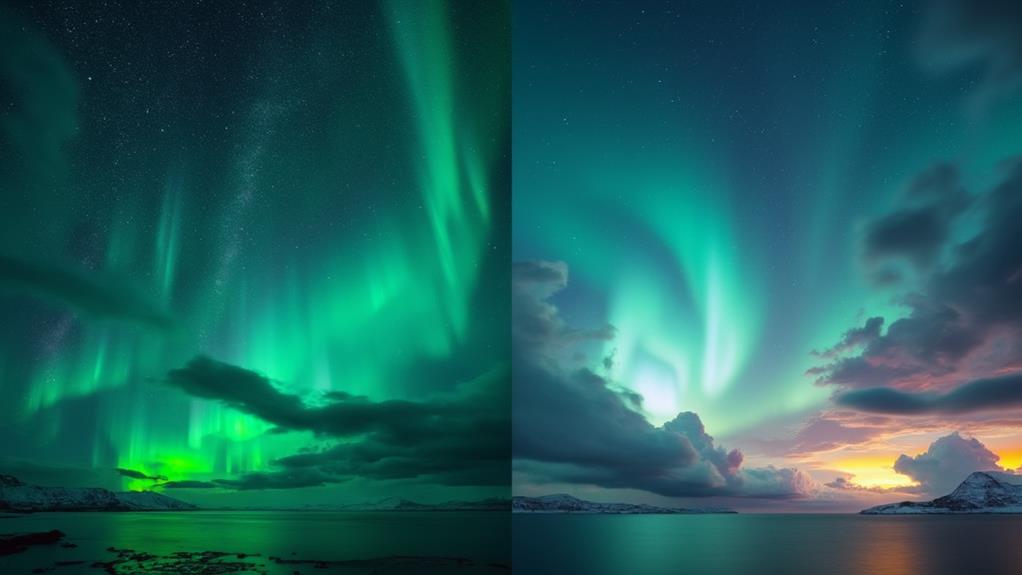
Observing the Northern and Southern Lights requires specific atmospheric conditions to maximize the experience. Here are the key factors to consider:
- Clear Skies: Essential for unobstructed views of the auroras.
- Dark Environments: Locations with minimal light pollution ensure the auroras are more visible.
- Cold Winter Nights: These provide longer hours of darkness and typically clearer skies.
- High Solar Activity: Monitoring the Kp index, which measures geomagnetic activity, helps predict the intensity of the auroras.
Technological Tools for Viewing
Leveraging technological tools can significantly enhance your experience when planning to witness the Northern and Southern Lights. Aurora forecast apps and websites provide real-time data on solar activity and Kp index levels, helping you identify the optimal times for viewing. These tools allow you to track the precise moments when auroras are most likely to appear.
High-quality camera equipment, such as DSLRs with manual settings, enables you to capture the intricate colors and patterns of auroras effectively. Smartphones equipped with augmented reality apps can assist in locating and tracking auroras in real-time based on your geographic location.
Advanced light pollution maps are invaluable for identifying prime locations away from artificial light, which is crucial for clear aurora viewing. Combining this with weather forecasting tools tailored for aurora viewing provides updates on cloud cover and atmospheric conditions, ensuring a successful outing.
Here's a quick guide to some essential tools:
| Tool | Functionality |
|---|---|
| Aurora Forecast Apps | Real-time solar activity and Kp index data |
| DSLR Cameras | High-quality, manual setting photography |
| Augmented Reality Apps | Real-time aurora tracking based on location |
| Light Pollution Maps | Identifying ideal, low-light viewing locations |
Using these tools together can maximize your chances of a memorable aurora viewing experience.

